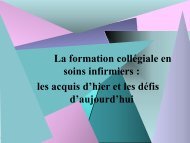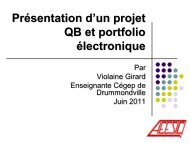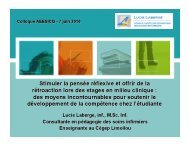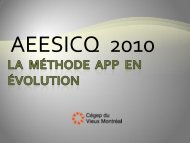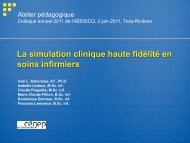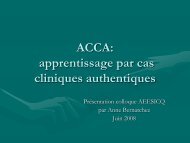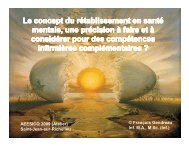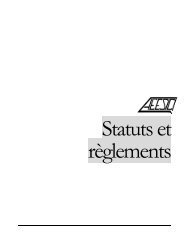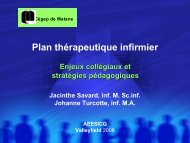Le Flambeau Volume 25 Numéro 1 - aeesicq
Le Flambeau Volume 25 Numéro 1 - aeesicq
Le Flambeau Volume 25 Numéro 1 - aeesicq
Create successful ePaper yourself
Turn your PDF publications into a flip-book with our unique Google optimized e-Paper software.
L’ASSOCIATION DES ENSEIGNANTES ET ENSEIGNANTS<br />
EN SOINS INFIRMIERS DES COLLÈGES DU QUÉBEC<br />
Mot de la présidente<br />
L'AEESICQ a le "vent dans les voiles". De nouvelles<br />
enseignantes se sont inscrites après avoir visité notre<br />
page Facebook. Cette nouvelle voie (voix) de communication<br />
a été réalisée grâce à l'initiative de Sylvie<br />
Rochon du Cégep de Trois-Rivières, conseillère au<br />
CA pour la région no 1. Nous sentons aussi une relative<br />
tranquillité quant aux menaces qui ont souvent<br />
pesé sur la formation en soins infirmiers au collégial<br />
: nous pouvons ainsi mettre notre énergie sur les<br />
dossiers pédagogiques.<br />
De fait, nous sommes à préparer, pour le 14 janvier<br />
2011, une journée pédagogique sur le partage des<br />
technologies de l’information et de la communication<br />
(TIC) utilisées en classes, en laboratoires et en stages<br />
par les profs de soins infirmiers. Enfin, et c’est le<br />
plus important, le C.A., en étroite collaboration avec<br />
le département de soins infirmiers du Cégep de Trois<br />
-Rivières, est à concrétiser le colloque annuel qui aura<br />
lieu les 2 et 3 juin 2011.<br />
Heureusement que le spectre de la grippe AH1N1<br />
n’est pas à l’horizon. Malgré la fatigue de fin de session<br />
et les difficultés d’évaluation des<br />
« compétences » des élèves, nous devons continuer à<br />
maintenir notre niveau de connaissances et d’enseignement,<br />
tenir compte des nouvelles compétences<br />
relatives au PTI, inclure les technologies de l’information<br />
dans notre enseignement et maintenir la collaboration<br />
avec nos partenaires du secteur de la santé.<br />
La question de la relève reste préoccupante. <strong>Le</strong>s départs<br />
laisseront un grand vide dans les départements<br />
de soins infirmiers, mais il est consolant de constater<br />
l’excellent niveau de formation des nouvelles arrivantes.<br />
Elles sont vives, intelligentes et ont à cœur la<br />
réussite des cohortes d’élèves dont elles sont responsables.<br />
Même si la réforme des programmes du secondaire<br />
n’est pas encore apparente, des défis nous attendent<br />
que nous devrons relever avec brio : apprentissage<br />
centré sur l’élève, paradigme constructiviste, responsabilités<br />
accrues des élèves et adaptation aux besoins<br />
nouveaux des populations vieillissantes dont la vulnérabilité<br />
est accrue par le croisement de leurs pro-<br />
Page 2 <strong>Le</strong> <strong>Flambeau</strong>, vol <strong>25</strong>, no 1, déc. 2010<br />
A quick word from your President<br />
AEESICQ has “the wind under its wings” as many teachers<br />
are becoming members after visiting our new Facebook<br />
page. Mrs. Sylvie Rochon from Cegep Trois-<br />
Rivières (representing region No 1) is the mastermind behind<br />
the creation of our page and we thank her.<br />
There is a relative calmness surrounding us right now as<br />
we do not perceive, as we did before, any specific threats<br />
to college nursing education; thus we can focus our energy<br />
on pedagogical dossiers.<br />
In doing so, we are preparing the upcoming pedagogical<br />
day on the sharing of Communication and Information<br />
Technologies (C.I.T.) used in the classrooms, labs and<br />
clinical settings by nursing teachers, and lastly, the Board<br />
is preparing the next colloquium scheduled for June 2 and<br />
3, in collaboration with our host, the nursing faculty of<br />
Cegep Trois-Rivières. We hope that this special gathering<br />
will be most instructive and stimulating for the membership.<br />
The end of the term always bring its load of fatigue and<br />
stress often related to the evaluation of students’ competencies<br />
(let’s be thankful that we do not have to deal with<br />
AH1N1 this year!); but regardless of how tired we are, we<br />
ought to keep working at maintaining current our nursing<br />
teaching, addressing the competencies that are emerging<br />
from use of the TNP, including CIT in our teachings, and<br />
maintaining the collaboration with our health care partners.<br />
We are also concerned by the increasing shortage of nursing<br />
teachers as many experienced teachers are retiring.<br />
Although their departure is leaving a void, we can see that<br />
the newly hired faculty members are extremely well educated.<br />
They fit right in: they are quick, intelligent and are<br />
already focused on students’ success.<br />
Although we do not immediately see the outcome of the<br />
high-school reform, we know that we will soon face some<br />
challenges related to it. We will have to adjust to the students’<br />
needs being at the center of their learning, to the<br />
constructivism paradigm, to the increased students’ responsibilities,<br />
and to the new needs of the hospitalized<br />
clients such as the elderly population whose vulnerability<br />
is increasing because of their overlapping physical and<br />
mental health problems.<br />
We are facing a new reality: the student cohort admitted to<br />
the program at age 18, is proportionally equal to the adult<br />
population, age 30 to 45, who is also admitted to the pro-



